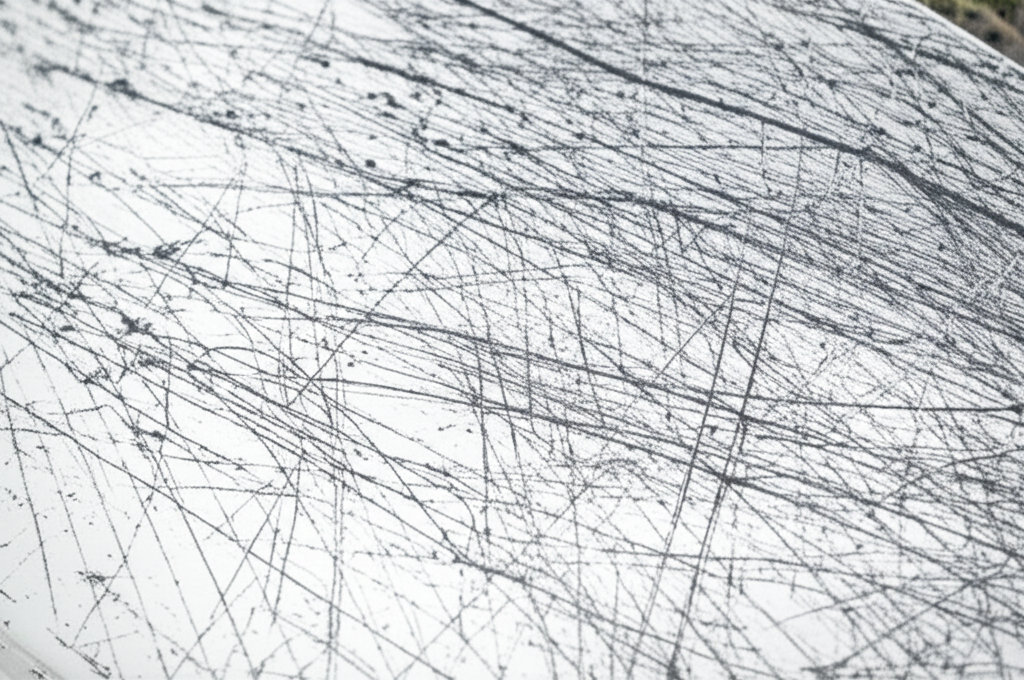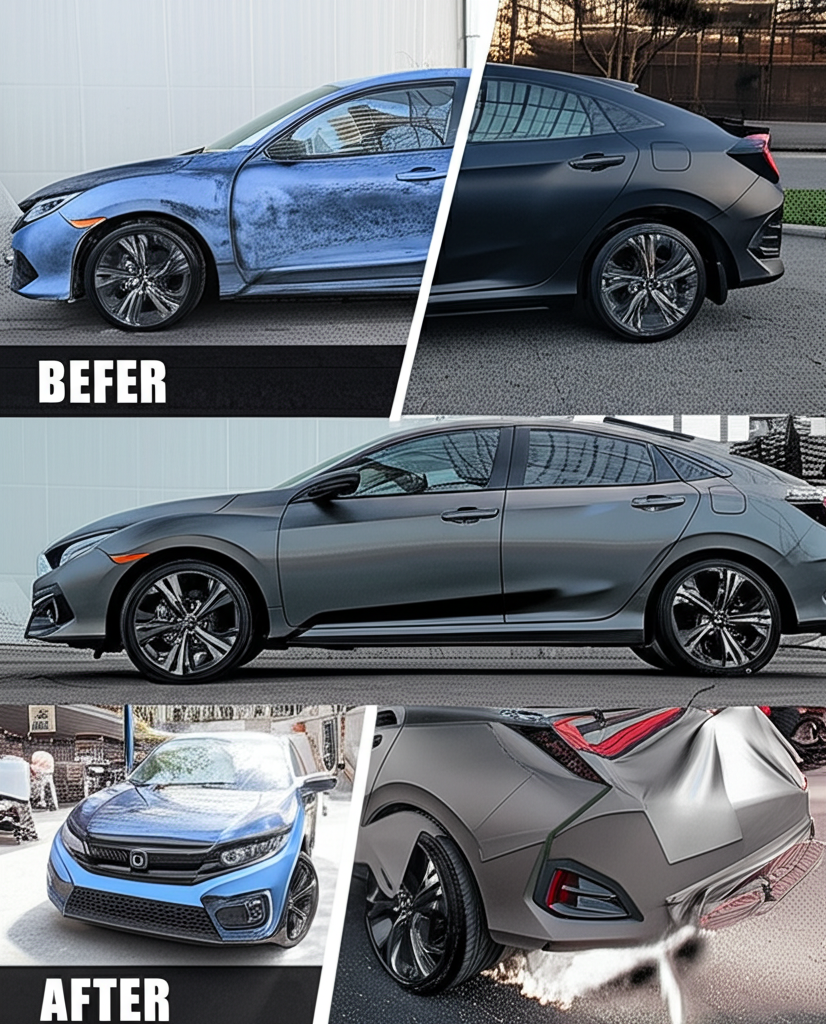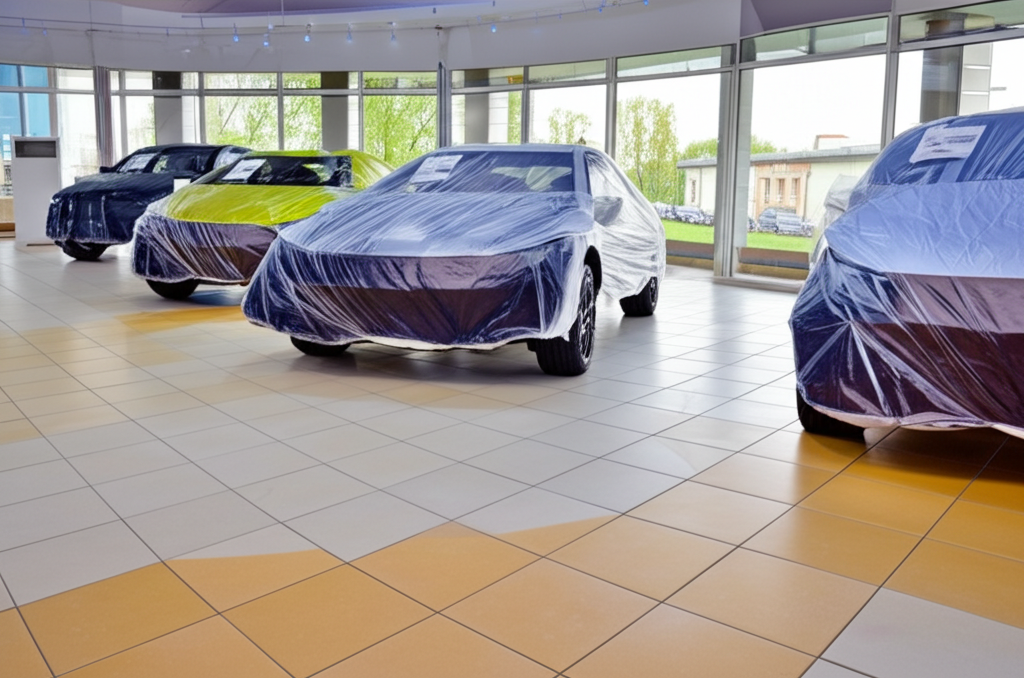In the competitive used car market here in Thailand, every detail matters. As a dealership, you know the daily challenge: moving inventory quickly and profitably. You’ve likely experienced the frustration – two similar cars, same model, same year, similar mileage. One flies off the lot, while the other sits, attracting lower and lower offers. What often makes the difference? The visual appeal. Specifically, the paint condition. It’s a simple truth: the newer the paint looks, the easier it sells; the older and more worn it appears, the more buyers will haggle the price down. Faded paint, swirl marks, minor scratches – they all scream “old” and “needs work,” even if the car is mechanically sound. This directly impacts your bottom line. But what if there was a cost-effective way to dramatically improve a car’s first impression and potentially increase its resale value without resorting to an expensive, time-consuming repaint? Could professional car wrapping be the answer for your dealership?

The Transformation: Turning a Tired Sedan into a Showroom Star
Let’s consider a common scenario. Meet “Somchai,” a fictional manager at a bustling Bangkok used car dealership. On his lot sat a 5-year-old Honda Civic – a popular model, mechanically reliable, but its dark blue paint had seen better days under the harsh Thai sun. It was faded in patches, particularly on the roof and bonnet, and sported numerous minor scratches from daily use. Despite a competitive price, potential buyers kept pointing out the paint flaws, using them as leverage for lower offers. Somchai knew a full repaint would cost a significant amount (potentially 30,000-50,000 Baht or more, depending on quality) and take the car off the market for weeks, tying up capital and space.
Instead, Somchai decided to partner with a local professional car wrapping shop. After consultation, they chose a modern and highly desirable colour: Satin Dark Grey. This choice was strategic – sophisticated, popular across various demographics, and excellent at hiding minor surface imperfections. The wrapping process itself was relatively quick. Within three days, the Civic underwent a stunning transformation. The professional wrap application covered the faded paint and minor scratches, giving the car a smooth, flawless, and contemporary finish. The satin effect added a touch of premium appeal that the original gloss paint lacked, even when new.
The result? The newly wrapped Civic looked years younger. When placed back on the lot, it immediately drew more attention. Viewers perceived it as a well-maintained, modern vehicle. Within a week, it sold – not just faster than Somchai had anticipated, but also closer to the original asking price, easily recouping the cost of the wrap and adding profit. The buyer was thrilled with the unique look and the fact that the original paint underneath was preserved. For Somchai, it was a clear win: faster sale, better price, and a valuable lesson learned about enhancing inventory appeal.

Wrapping vs. Repainting: A Strategic Choice for Used Car Inventory
Understanding the differences between vinyl wrapping and traditional repainting is crucial for making informed decisions about refreshing your used car stock. While both can change a car’s appearance, they serve different purposes and offer distinct advantages, especially in the context of resale.
Vinyl Car Wrapping involves applying large sheets of adhesive-backed vinyl film directly over the vehicle’s existing paintwork. It’s a non-permanent modification, meaning the wrap can be removed later without damaging the original paint, provided the paint was in good condition initially and the removal is done professionally. This is a key benefit for resale, as it preserves the car’s factory finish underneath.
Repainting is a permanent process that involves stripping the old paint (to varying degrees), repairing any body damage, priming, and applying new layers of paint and clear coat. While essential for repairing significant damage or corrosion, it’s often more expensive and time-consuming than wrapping, and it permanently alters the vehicle from its original state.
Here’s a comparison focusing on aspects relevant to used car dealerships in Thailand:
| Feature | Vinyl Wrap | Traditional Repaint |
|---|---|---|
| Primary Purpose (Used Cars) | Cosmetic refresh, colour change, hiding minor imperfections (swirls, light scratches, fading), protecting original paint. | Permanent colour change, repairing moderate to severe paint/body damage, addressing rust. |
| Cost (Indicative – Thailand) | Generally Moderate (e.g., starting from ~20,000 Baht upwards for a quality full wrap on a sedan, depending on film and complexity). Can be significantly less than a high-quality repaint. | Moderate to Very High (e.g., ~30,000 Baht for basic quality, up to 80,000+ Baht for high-quality, factory-like finish). Costs vary greatly with prep work needed. |
| Turnaround Time | Relatively Fast (Typically 2-5 days for a full wrap). Minimises time the car is off the sales lot. | Slower (Typically 1-3 weeks, sometimes longer depending on bodywork). Increases holding time and costs. |
| Reversibility | Yes. Can be removed professionally, revealing and preserving the original paint underneath. This can be a selling point. | No. Permanent change to the vehicle. May raise questions about accident history if not documented. |
| Original Paint Protection | Excellent. Acts as a protective layer against new scratches, stone chips, UV fading (crucial in Thailand’s climate). | N/A. The repaint *is* the new surface. Original paint is removed or covered permanently. |
| Durability / Lifespan (Thailand Climate) | Good Quality Film: 3-7 years with proper care (UV resistant films recommended). Can withstand heat and rain. | Depends heavily on quality. Good repaint: 5-10+ years. Poor quality: Can fade, peel, or crack sooner, especially in strong sun. |
| Impact on Resale Value | Can significantly increase appeal and potentially value by making the car look newer/more desirable. Preserves original paint option. Cost-effective refresh. | Can increase value if done well and original paint was very poor/damaged. However, high cost may not be fully recouped. Buyers might be wary of non-factory paint jobs (potential accident cover-up). |
| Best Suited For | Mechanically sound cars with cosmetically tired but intact original paint. Quick visual upgrades for faster sales. Offering custom looks. Protecting paint on slightly newer used models. | Cars requiring significant bodywork or rust repair. Complete colour change needed permanently. Restorations where original paint is beyond saving. |
For many used cars on your lot suffering from aesthetic wear but otherwise in good shape, wrapping presents a compelling business case. It’s faster, often cheaper than a quality repaint, protects the underlying asset (original paint), and offers a modern look that resonates with current buyer preferences.
Dealer and Buyer Reactions: The Shift in Perception
The decision to wrap isn’t just about covering old paint; it’s about changing perceptions and eliciting positive emotions. Here’s what we hear:
“We wrapped a 4-year-old pickup truck that had typical work-related scratches. We chose a tough-looking matte green. It sold within 4 days to someone who loved the unique, rugged style. Similar unwrapped trucks were sitting for weeks. The wrap definitely gave it the edge and justified a slightly higher price.” – Dealership Owner, Chonburi
“I bought a wrapped used SUV. Honestly, the colour caught my eye first – it was a beautiful satin blue. The dealer explained it was a wrap protecting the original silver paint. For me, it was a bonus: a modern look now, and the option of going back to factory paint later if I wanted. It felt like getting a newer, more special car.” – Car Buyer, Bangkok
“The biggest change is speed. Wrapped cars just seem to generate more interest online and in person. Less haggling over paint chips means smoother negotiations. It’s become a standard part of our reconditioning process for certain vehicles now. The investment pays off quickly.” – Sales Manager, Chiang Mai Dealership
The emotional shift is palpable. For dealers, it’s moving from the anxiety of slow-moving stock and price cuts to the confidence of presenting highly desirable vehicles. For buyers, it’s the excitement of finding a unique, fresh-looking car that feels like a smart purchase, combining style with the underlying value of protected original paint.
Ready to Enhance Your Inventory’s Appeal and Value?
Stop letting tired paint diminish the value of your otherwise solid used car inventory. Consider the strategic advantage that professional car wrapping can offer. It’s a proven way to:
- Dramatically improve visual appeal and first impressions.
- Attract more potential buyers, faster.
- Potentially achieve higher selling prices and reduce haggling.
- Protect the original paintwork, preserving asset value.
- Offer unique, modern aesthetics that stand out in the market.
Partnering with an experienced wrapping specialist ensures quality results that reflect positively on your dealership’s reputation. Explore how a targeted wrapping strategy can transform your slowest movers into showroom stars.
Contact us today to discuss how we can collaborate to enhance your used car inventory through professional wrapping services tailored to the Thai market.
📱 Want to learn more about car wrap & paint protection?
Feel free to reach us on LINE:

🌐 Official Website: https://tpuwraps.com
Frequently Asked Questions (FAQ) for Dealerships
- Q: Is car wrapping a cost-effective investment for increasing used car value?
- A: In many cases, yes. While there’s an upfront cost, the potential benefits – faster sale, higher selling price, reduced holding costs, and enhanced customer appeal – often outweigh the investment. Compared to a quality repaint, wrapping is frequently more affordable and quicker, providing a faster ROI, especially for cars with cosmetically challenged but otherwise intact paint.
- Q: Will potential buyers be hesitant about buying a wrapped used car?
- A: Transparency is key. Explain that the wrap is a cosmetic enhancement and protects the original paint underneath. Many buyers see it as a plus – a modern look without the permanence (or potential hidden issues) of a repaint. Highlighting the paint protection aspect, especially in Thailand’s climate, adds value. Offering photos of the car *before* the wrap can also build trust.
- Q: How long does a professional car wrap typically last in Thailand’s hot and humid climate?
- A: With quality vinyl film (like those from reputable brands such as 3M, Avery Dennison) and professional installation, a wrap can last 3 to 7 years, sometimes longer with proper care. Choosing films with good UV resistance is important. Regular washing (avoiding high-pressure jets directly on edges) helps maintain its appearance and longevity.
- Q: What colours or finishes are generally best for resale value when wrapping a used car?
- A: While trends change, popular choices often include modern neutrals (Nardo Grey, satin/matte black, white, silver variations), deep metallics, and currently fashionable OEM colours. Satin and matte finishes are very popular for adding a premium look. It’s generally wise to avoid extremely bright or niche colours unless targeting a specific demographic, as mainstream appeal often leads to quicker sales.
- Q: Can a wrap hide serious body damage or rust?
- A: No, and reputable wrap shops will not apply vinyl over significant rust, dents, or poorly repaired areas. Vinyl film conforms to the surface, so major imperfections will still be visible. Wrapping is intended for cosmetically enhancing structurally sound surfaces with intact paint (even if faded or lightly scratched). It’s not a substitute for proper body repair.
Conclusion: Wrap Your Way to Better Used Car Sales
In the dynamic Thai used car market, standing out is essential. As we’ve seen, the condition of a car’s exterior profoundly impacts buyer perception and your final sale price. While a full repaint has its place, professional car wrapping offers a compelling alternative – a faster, often more cost-effective, and reversible solution to revitalise a vehicle’s appearance.
By strategically using high-quality vinyl wraps, you can transform tired-looking inventory into eye-catching, desirable vehicles that sell faster and potentially fetch higher prices. It addresses the core challenge: making older cars look newer and more appealing. Embrace this modern restyling tool and see how it can positively impact your dealership’s turnover and profitability.
Don’t let faded paint cost you sales. Explore the potential of car wrapping today.
